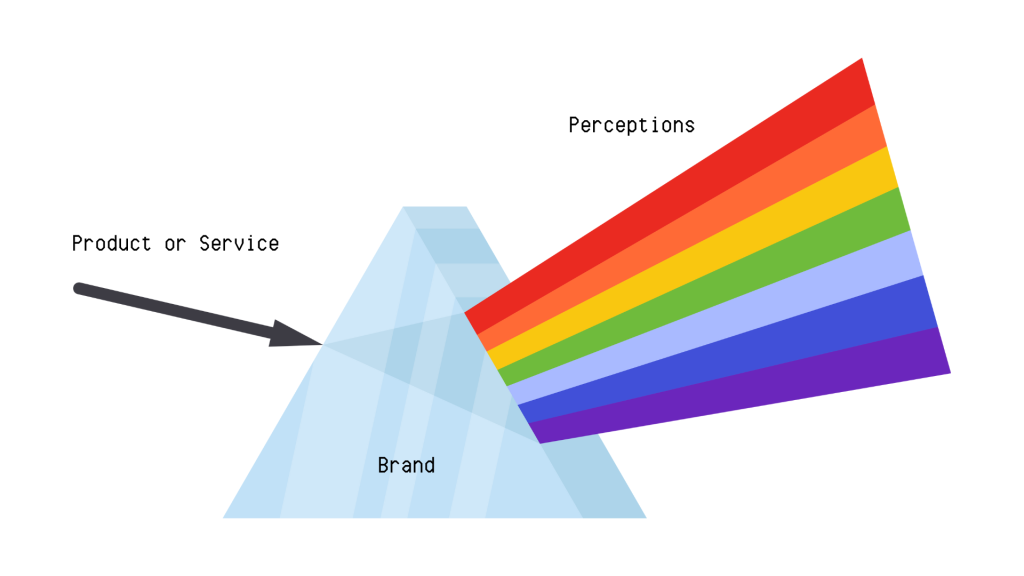A strong, appealing brand is one of the most valuable assets a company can have. It shapes consumer perception, builds trust, and elevates a product beyond its basic function, allowing businesses to command premium pricing and long-term loyalty.
Beyond selling their products, brands sell ideas, emotions, and experiences. Whether it’s a luxury name elevating the perceived value of an item or an edgy, rebellious brand making a commodity feel premium, branding plays a pivotal role in shaping consumer behavior.
This concept is best understood through the Brand Prism.
The Brand Prism
Being more than catchy names and logos, Brands act as a lens that transforms the way we interpret value. The Brand Prism helps us understand this. Its framework that demonstrates how brands influence consumer perception.
It illustrates how brands function as a filter between the product and consumer perceptions. And it shows that people rarely assess a product on its features alone. Instead, they interpret products or services through the reputation, associations, and emotional triggers attached to the brand.

In a study from Kansas State University and Pusan National University, titled Roles of Brand Value Perception in the Development of Brand Credibility and Brand Prestige, researchers found that a brand’s perceived value plays a critical role in shaping consumer trust and loyalty. The study, conducted in the coffeehouse industry, revealed that brands seen as credible (reliable and high-quality) or prestigious (socially aspirational and emotionally fulfilling) can command higher consumer loyalty—regardless of price.
It found that consumers were willing to pay a premium for brands that aligned with their self-image, delivered enjoyable experiences, or reinforced social identity. This reinforces the idea that brand perception, not just product quality, is a key driver of pricing power, purchase intent and allows brands to justify premium pricing.
With this framework in mind, let’s explore how major brands have successfully leveraged perception to enhance their value.
The Beyoncé Effect
Beyoncé is one of the most powerful cultural influencers in the world, and her impact on branding is undeniable. Known as the Beyoncé Effect, her association with a brand can elevate its visibility, desirability, and—most importantly—its perceived value.
Consider what happened when she released Cowboy Carter, featuring a track titled “Levii’s Jeans.” As a result of this organic brand mention, Levi’s stock surged 20%, store foot traffic spiked by nearly 20%, and social media exploded with brand mentions. Recognizing the moment, Levi’s strategically leaned into the hype, temporarily rebranding themselves as “Levii’s” on social media and launching a campaign featuring Beyoncé herself (People).
The impact was more than just visibility—it changed how consumers perceived Levi’s, elevating the brand to an aspirational status, further allowing it to command premium pricing.
Apple – The Ultimate Master of Perception
Apple is a prime example of a brand that has perfected the art of shaping perception. By focusing on sleek design, innovation, and user experience, Apple has cultivated a reputation of exclusivity and quality.
Despite competitors offering similar or even superior hardware, Apple consistently commands premium prices for its products. Its brand is synonymous with cutting-edge technology, allowing it to maintain strong customer loyalty and market dominance. A McKinsey report found that strong brand recognition allows companies to charge 5-10% higher prices—a principle Apple has exemplified for decades.
Liquid Death – Making Water Premium
Water is the most basic commodity, yet Liquid Death has managed to turn it into a premium lifestyle product. How? Branding power.
By packaging water in tallboy aluminum cans with a punk rock aesthetic and irreverent marketing, Liquid Death has positioned itself as an alternative to mainstream bottled water. Its brand appeals to a niche audience that values rebellion and humor, allowing it to charge significantly higher prices than competitors. An analysis by Forbes highlights how the brand’s valuation has soared to $1.4 billion, proving that even a commodity like water can be transformed into a high-value product through branding alone.
Conclusion: Branding is the Ultimate Value Multiplier
The common thread in all these examples is that Brand can be the ultimate driver of perceived value. Whether it’s an endorsement from a cultural icon, a legacy of innovation, or an unexpected marketing approach, brands have the power to reshape consumer perception and, in doing so, command higher prices.
Understanding this principle allows businesses of all sizes to elevate their products and services beyond mere functionality. In a marketplace where perception often matters more than reality, the companies that invest in brand-building will be the ones that thrive.
Key Takeaways:
- Consumers don’t buy products; they buy perceptions.
- The Brand Prism explains how branding alters the way consumers interpret value.
- Studies confirm that strong brand perception leads to higher willingness to pay.
- Brands like Beyoncé, Apple, and Liquid Death have successfully leveraged perception to command premium pricing.
By mastering brand perception, companies can create value where none existed before—and that’s the true power of branding.
